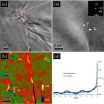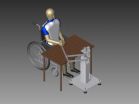(Press-News.org) RENO – An international team of scientists, led by Dr. Alison Murray, an Associate Research Professor at the Desert Research Institute's Division of Earth and Ecosystem Sciences reported this week in the Proceedings of the National Academy of Science (PNAS) that a clear difference exists between the marine microbial communities in the Southern and Artic oceans, contributing to a better understanding of the biodiverisity of marine life at the poles and its biogeography.
This new understanding not only sheds light on newly recognized biodiversity patterns but reinforces the importance of study of Earth's polar regions in the face of a changing climate and identifies further need for research on the impacts of sea ice, seasonal shifts, and freshwater input in both regions.
Findings from the most comprehensive comparison of bacterioplankton diversity at both of the Earth's polar oceans showed that about 75 percent of the organisms at each pole are different.
"We believe that significant differences in the environmental conditions at each pole and unique selection mechanisms in the Artic and Southern oceans are at play in controlling surface and deep ocean community structure," said Murray, whose participation on this new report resulted from her role as a representative for the U.S. on the Scientific Committee for Antarctic Research (SCAR). Murray, a polar researcher for the past 17 years, has participated in 14 expeditions to the Southern Ocean and Antarctic continent to conduct research and educational activities and worked on the Arctic tundra lake ecosystems in northern Alaska. She also recently authored a policy forum article on major conservation challenges facing the Antarctic region that was published by Science magazine in July, 2012.
Scientists found that the differences between the two poles were most pronounced in the microbial communities sampled from the coastal regions, which is – "likely a result of the significant differences in freshwater sourcing to the two polar oceans," said Dr. Jean-François Ghiglione, lead author of the report and research professor at the French Microbial Oceanography Laboratory (Observatoire Océanologique) in Banyuls-Sur-Mer.
Dr. Ghiglione adds that in the Southern Ocean, glacial melt-water accounts for most of the freshwater that flows into the system. In contrast, the Arctic Ocean receives much bigger pulses of freshwater from several large river systems with huge continental drainage basins, in addition to glacial melt-water.
While the surface microbial communities appear to be dominated by environmental selection, noted the report's authors, the deep ocean communities are more constrained by historical events and connected through oceanic circulation, providing evidence for biogeographically defined communities in the global ocean.
This unique collaboration was the result of an international effort coordinated by Murray involving scientists from six countries – Canada, France, New Zealand, Spain, Sweden and the United States. The collaboration was made possible through the International Polar Year, a global research campaign, and the Sloan Foundation's Census of Marine Life Program, which stimulated field efforts at both poles as well as a separate program targeting marine microbes – International Census of Marine Microbes (ICoMM). Further, the National Polar Research programs from each of the six contributing nations, including the National Science Foundation, supported field expeditions.
"The collective energies required to bring this study to fruition was remarkable," Murray said. "By using similar strategies and technologies in sample collection through next-generation sequencing, we have a highly comparable, unprecedented dataset that for the first time has allowed us to take an in-depth look across a large number of samples into the similarities of the microbial communities between the two polar oceans."
Scientists compared 20 samples from the Southern Ocean against 24 similar samples from the Arctic Ocean taken from both surface and deep waters sites. They also included an additional 48 samples from Earth's lower latitudes to investigate the polar signal in global marine bacterial biogeography.
The researchers specifically compared samples from coastal and open oceans and between winter and summer seasons, to test whether or how environmental conditions and dispersal patterns shape microbial communities in the polar oceans. Samples were processed and analyzed by ICoMM, using an identical approach based on pyrosequencing and involving more than 800,000 sequences from each of the 92 samples.
"Our analyses identified a number of key organisms in both poles in the surface and deep ocean waters that are important in driving the differences between the communities," Murray said. "Still, further research is needed to address the ecological and evolutionary processes that underlie these unique patterns."
###About the Desert Research Institute:
DRI, the nonprofit research campus of the Nevada System of Higher Education, strives to be the world leader in environmental sciences through the application of knowledge and technologies to improve people's lives throughout Nevada and the world.
All DRI news releases available at: http://news.dri.edu/
DRI scientist co-authors study outlining vast differences in polar ocean microbial communities
Comprehensive comparisons of biodiversity reinforce the need for further research in these sensitive regions
2012-10-09
ELSE PRESS RELEASES FROM THIS DATE:
Near atomic-scale deformation fields of a crack-tip were mapped experimentally at IMUT
2012-10-09
The fracture of materials is a very important issue for both structural and functional materials. Crack-tip behavior is among the most basic problems in fracture mechanics. Many theoretical and experimental investigations have been carried out to understand the effect of crack-tip deformation fields. However, direct nanoscale measurement of strain fields around the crack-tip has not yet been achieved, despite many years of research. Professors Zhao ChunWang and Xing YongMing from Inner Mongolia University of Technology set out to tackle this problem. They adopted a combination ...
Language learning makes the brain grow
2012-10-09
At the Swedish Armed Forces Interpreter Academy in the city of Uppsala, young people with a flair for languages go from having no knowledge of a language such as Arabic, Russian or Dari to speaking it fluently in the space of 13 months. From morning to evening, weekdays and weekends, the recruits study at a pace unlike on any other language course.
As a control group, the researchers used medicine and cognitive science students at Umeå University – students who also study hard, but not languages. Both groups were given MRI scans before and after a three-month period of ...
Power in the palm of your hands
2012-10-09
Forget the TV remote and the games controller, now you can control anything from your mobile phone to the television with just a wave of your hand.
Researchers at Newcastle University and Microsoft Research Cambridge (MSR) have developed a sensor the size of a wrist-watch which tracks the 3-D movement of the hand and allows the user to remotely control any device.
Mapping finger movement and orientation, it gives the user remote control anytime, anywhere – even allowing you to answer your phone while it's still in your pocket and you're walking down the street.
Being ...
Catalytic converters like it hot
2012-10-09
This press release is available in German. Catalytic converters work poorly if they have not yet warmed up. Tiny metal particles in a catalytic converter require a minimum temperature to function efficiently. At the Vienna University of Technology, thanks to a new measuring method, it has now become possible to examine many different types of these particles at the same time. Reliable information regarding what it is exactly that the efficiency of catalytic converters depends on has thus been obtained for the first time.
Low ignition temperature desired
"A large part ...
Digital tabletop system with views on demand
2012-10-09
A tabletop system where users can come together and view shared content will be unveiled today [Tuesday 9 October]. A team of scientists, led by the University of Bristol, have developed the system aimed at supporting mixed-focus collaborative tasks.
Researchers from the University's Department of Computer Science will present PiVOT (personalised view-overlays for tabletops) at the 25th ACM UIST 2012, a symposium for innovations in the software and technology of human-computer interfaces.
Through two view zones, PiVOT provides personalised views to individual users ...
Scientists develop a blood test that detects aggressive prostate cancers
2012-10-09
Scientists from the Spanish National Cancer Research Centre (CNIO) in Madrid, along with British colleagues from the Institute for Cancer Research (ICR) and the Royal Marsden NHS Foundation Trust, have developed a test that studies genetic patterns in blood cells to detect advanced–stage prostate cancer. The results of the study are being published today in the journal The Lancet Oncology.
The study shows that gene patterns in blood cells act as a barcode and could be used together with the current PSA test to select those patients with the worst prognosis in need of ...
Liquorice offers clue to cleaner medical implants
2012-10-09
Oxford, October 8, 2012 - A nanotech material containing an extract from liquorice can be used to sterilize and protect medical devices and implants which include biological components, and protects these functional bio-components during the sterilization process.
Publishing their findings in the latest issue of Materials Today, a team of researchers from Germany and Austria explain how conventional sterilization techniques based on a blast of radiation, or exposure to toxic gas can damage the functional biological components of the device. The coating, containing a component ...
New methods might drastically reduce the costs of investigating polluted sites
2012-10-09
This press release is available in German.Ferrara/Leipzig. New methods might allow polluted sites to be investigated and monitored long term at significantly reduced costs. Authorities and those who have to remediate polluted sites in Europe might therefore be able to save costs and use these to treat other areas. This is the conclusion of the EU research project ModelPROBE, which was coordinated by the UFZ. The results, with which the scientists aimed to lower the workload of authorities and consultants, include a handbook detailing the methods for characterising contaminated ...
Worldwide patent for a Spanish stroke rehabilitation robot
2012-10-09
VIDEO:
This is about the worldwide patent for a Spanish stroke rehabilitation robot.
Click here for more information.
Robotherapist 3D, a robot which aids stroke patients' recovery, is to be brought to market by its worldwide patent holder, a spin-off company from the Miguel Hernández University of Elche (Alicante, Spain). It is the first robot to enable patients to start doing exercises while supine, allowing them to begin shortly after the stroke and expediting recovery. ...
River Thames invaded with foreign species
2012-10-09
Almost 100 freshwater species not native to the UK have invaded the River Thames catchment making it one of the most highly invaded freshwater systems in the world, according to scientists at Queen Mary, University of London.
The research, published in the journal Biological Invasions at the weekend, suggests that legislation to prevent the introduction of non-native species across the UK has been unsuccessful. The cost to the British economy of invasive non-native species is £1.7bn every year (CABI report, 2010).
Lead author, Dr Michelle Jackson* who undertook the ...
LAST 30 PRESS RELEASES:
Making lighter work of calculating fluid and heat flow
Normalizing blood sugar can halve heart attack risk
Lowering blood sugar cuts heart attack risk in people with prediabetes
Study links genetic variants to risk of blinding eye disease in premature infants
Non-opioid ‘pain sponge’ therapy halts cartilage degeneration and relieves chronic pain
AI can pick up cultural values by mimicking how kids learn
China’s ecological redlines offer fast track to 30 x 30 global conservation goal
Invisible indoor threats: emerging household contaminants and their growing risks to human health
Adding antibody treatment to chemo boosts outcomes for children with rare cancer
Germline pathogenic variants among women without a history of breast cancer
Tanning beds triple melanoma risk, potentially causing broad DNA damage
Unique bond identified as key to viral infection speed
Indoor tanning makes youthful skin much older on a genetic level
Mouse model sheds new light on the causes and potential solutions to human GI problems linked to muscular dystrophy
The Journal of Nuclear Medicine ahead-of-print tip sheet: December 12, 2025
Smarter tools for peering into the microscopic world
Applications open for funding to conduct research in the Kinsey Institute archives
Global measure underestimates the severity of food insecurity
Child survivors of critical illness are missing out on timely follow up care
Risk-based vs annual breast cancer screening / the WISDOM randomized clinical trial
University of Toronto launches Electric Vehicle Innovation Ontario to accelerate advanced EV technologies and build Canada’s innovation advantage
Early relapse predicts poor outcomes in aggressive blood cancer
American College of Lifestyle Medicine applauds two CMS models aligned with lifestyle medicine practice and reimbursement
Clinical trial finds cannabis use not a barrier to quitting nicotine vaping
Supplemental nutrition assistance program policies and food insecurity
Switching immune cells to “night mode” could limit damage after a heart attack, study suggests
URI-based Global RIghts Project report spotlights continued troubling trends in worldwide inhumane treatment
Neutrophils are less aggressive at night, explaining why nighttime heart attacks cause less damage than daytime events
Menopausal hormone therapy may not pose breast cancer risk for women with BRCA mutations
Mobile health tool may improve quality of life for adolescent and young adult breast cancer survivors
[Press-News.org] DRI scientist co-authors study outlining vast differences in polar ocean microbial communitiesComprehensive comparisons of biodiversity reinforce the need for further research in these sensitive regions


